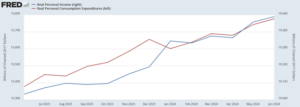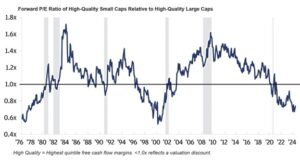The Summer Storm: Understanding Market Volatility
August 8, 2024
By Gerald B. Goldberg, JD, CIMA®, CEO, and Co-Founder
Markets have been more volatile than usual over the past few weeks, with several market-moving episodes disrupting this year’s mostly steady growth. After peaking in mid-July, the S&P 500 index fell by nearly 6% following a disappointing corporate earnings season. Despite staging a small recovery, the index stumbled again on the back of a weak labor report, with Monday’s 3% decline the worst single session performance in about two years.[1]
While some of these fluctuations were exacerbated by technical factors (including the rapid unwinding of the Japanese yen “carry trade”), they are linked by a common concern that the U.S. economy may be slipping into a recession.[2] Although the economy has shown extraordinary resilience in the face of the Federal Reserve’s interest rate hikes, investors now fear that a recent string of weak data points are revealing cracks in the foundation.
As long-term investors, we know that periodic episodes of increased volatility are par for the course. The time to prepare for these episodes is by building resilient portfolios before they occur, not by reacting emotionally in the moment. Still, exploring the nuances driving increased volatility can help us understand why markets are acting the way they are and what we might expect in the near future.
In this edition of Gerry’s Journal, I will explore the forces driving recent market fluctuations and what role the Federal Reserve will play in dictating our near-term path. In addition, I will describe why forecasts of economic calamity appear far too pessimistic in the current environment.
Recession risks have increased – but still appear small
In the face of recent economic and financial data, investors are justified in thinking that the probability of a U.S. recession over the next 6-12 months has increased. But although this risk has likely increased, it remains small overall.
Take the recent corporate earnings season. While it is true that the results of certain companies disappointed the market, these companies were largely confined to the technology sector, where artificial intelligence hype appears to have run ahead of itself. Based on the results so far, more than 75% of S&P 500 companies exceeded earnings expectations and overall year-on-year earnings growth has eclipsed 10%.[3] Any disappointment stemming from this earnings season says more about elevated market concentration in large technology stocks than it does about the overall quality of earnings.[4]
A more compelling bearish data point was July’s labor report. Released on August 2nd, the report showed unemployment rising 0.2 points for the fourth consecutive monthly increase.[5] Still, this rise is occurring from a historically low level. Since 2000, the average monthly unemployment reading has been 5.7%, well below the current rate of 4.3%.[6] Moreover, lower-than-anticipated initial jobless claims today show that this unemployment data may have been a one-off. [7]
The strength of the U.S. economy largely rests on the strength of the U.S. consumer, with consumer spending accounting for just over two-thirds of gross domestic product.[8] By and large, the U.S. consumer does seem to be in good shape, with both inflation-adjusted income and expenditures growing over the past year.[9],[10] On the back of these trends, the advance estimate for GDP growth in Q2 stood at a healthy 2.8%.[11] While future adjustments may mark that figure down slightly, such a reading is hardly the sign of an ailing economy.

Source: St. Louis Federal Reserve
It is important not to overstate the point. Other measures of consumer health, like credit card delinquency rates, do not paint such a rosy picture.[12] Overall, however, the fundamental data does not support the idea that a recession is lurking just around the corner. In my view, the market is reacting to a few isolated data points that lack the context of broader measures.
The Fed must strike a balance
Despite the preceding analysis, more than a few market commentators have grabbed headlines by fanning the flames of investor anxiety, especially in relation to the Federal Reserve’s interest rate decisions. The Chief Economist at Moody’s Analytics, one of the biggest ratings agencies in the country, recently stated that the Fed “obviously” made a mistake by keeping rates steady at their August meeting.[13] More provocatively, one economics professor from the University of Pennsylvania called on the Fed to make an immediate emergency interest rate cut.[14]
While it is true that the recent uptick in economic uncertainty will likely strengthen the Fed’s resolve to launch a cutting cycle at their September meeting, I do not agree that they made a mistake by leaving rates unchanged in August. Moreover, any reactive measures by the Fed in response to the latest episode of market volatility may ultimately do more harm than good.
Consider the possibility of an emergency interest rate cut, which the Fed has employed just a few times in history (most notably during the financial crisis in 2008 and the Covid market crash in 2020).[15] As the name suggests, emergency cuts are designed for emergencies. If the Fed decides that such a response is necessary, they may spook the market by signaling that the economic situation is truly calamitous. In addition, the feedback loop stemming from the resulting investor fear and uncertainty may end up leading to a more severe economic contraction than would otherwise have occurred.
This same logic largely applies to the possibility of a 50-basis-point interest rate cut at the Fed’s September meeting. Currently, markets expect a smaller cut, placing the probability of a 25-basis-point cut at approximately 63.5%.[16] Opting for a more significant cut could prove to be a dovish surprise – but also risks sending a negative signal on the economic situation.
Focusing on the Fed’s next move is valuable insofar as the central bank’s decisions are critical to how the market and the economy will evolve in the near future. And the Fed’s “data-dependent” approach may ultimately justify a larger rate cut in September if fundamental data shows continued weakness.[17] But in the current environment, the risk is not just that the Fed might do too little, but that they might do too much.
Who will benefit the most from rate cuts?
For long-term investors, episodes of market volatility rarely offer a reason to make structural changes to your allocation. With that said, such episodes can sometimes contain information that help us understand how investment opportunities might unfold in the near future.
Overall, the economic uncertainty reflected by recent volatility makes equities comparatively more attractive than bonds. At first glance, that might sound backward, especially considering the historical role of bonds as a safe-haven asset. Greater uncertainty, though, makes a sustained Fed cutting cycle more likely, and riskier assets like equities tend to benefit more from rate cuts than safer ones. Interest rates on bonds have also begun to fall in anticipation of Fed cuts, making fixed-income assets less enticing. Since mid-July, the yield on a 10-year Treasury has already dropped by about 25 basis points.[18]
While interest rate cuts will likely benefit equity markets broadly, certain categories are better poised to capture those benefits than others. Currently, smaller companies are struggling the most to manage higher interest rates, in large part due to their greater use of floating-rate debt when compared with larger companies.[19] Logically, if smaller companies struggled more with higher rates, they will likely benefit more from lower rates.
Current valuation levels could also add firepower to this dynamic. One way to measure equity valuation is with the forward price-earnings (PE) ratio, which measures the price you will have to pay per dollar of estimated earnings over the next year. Currently, the forward PE ratio for high-quality small-caps is about 75% of high-quality large-caps, indicating that smaller companies are relatively cheaper.[20]

Source: Adapted from JPMorgan
More generally, recent market trends that have favored highly profitable large-cap tech stocks may finally be coming to an end. In a looser rate environment, it is easier for non-blue-chip companies to access the financing they need to grow. Of course, such companies also tend to be riskier plays, with fluctuating share prices and uncertain business outcomes. But the coming cutting cycle, when combined with current valuation levels, will likely reward investors with the intestinal fortitude to back these companies.
In the long run, fundamentals matter most
I have yet to discuss some of the most high-profile sources of uncertainty dominating the news cycle right now, especially the U.S. presidential election and geopolitical tension in the Middle East and China. Along with economic uncertainty, these factors are doubtless contributing to elevated market volatility. It is a surprising fact of investing, though, that the most headline-grabbing stories are often the ones with the least amount of impact on our asset allocation decisions.
While Vice President Harris replacing President Biden as the Democratic candidate was certainly an important political development, it did little to change the investment implications of the race. Whether Trump or Harris is ultimately elected might make a difference in terms of tax rates, global trade, and domestic stimulus policy. Neither result, though, alters our fundamental investment outlook over the long term. While it is easy to be drawn into the vortex of hyperbole and polarization that accompanies U.S. politics, this vortex offers little information for investors interested in making intelligent decisions.
Geopolitical developments, meanwhile, can certainly alter our investment outlook in quite significant ways. Unfortunately, however, these omnipresent risks are impossible to predict or time with meaningful accuracy. As investors, the best that we can do to manage geopolitical risk is to maintain a sensible “dry powder” allocation in cash and U.S. Treasuries to deploy tactically in the event of major shifts.
Considering these macro drivers, as well as the continued evolution of the underlying economic data, the current round of volatility may continue for some time. The VIX index, a measure of expected volatility commonly known as Wall Street’s “fear gauge,” currently sits at a historically elevated level.[21] But to paraphrase Ben Graham, the father of value investing, the market is a voting machine in the short run and a weighing machine in the long run.[22]
Over the course of days, weeks, and months, prices are driven by emotions like greed and fear. Over the course of years, though, they are driven by the fundamentals. Therefore, as long-term investors, we must remain diligent in our focus on the fundamentals, even as the emotions of the market swirl around us.
Should you have any questions about the topics discussed in this edition of Gerry’s Journal, or how your portfolio is situated to handle market fluctuations, I invite you to reach out to our team today. As always, our office stands by to assist you, especially during moments of increased volatility.
1The views contained in this presentation represent the opinions of GYL Financial Synergies, LLC as of the date hereof unless otherwise indicated. This and/or the accompanying information was prepared by or obtained from sources GYL Financial Synergies, LLC believes to be reliable but does not guarantee its accuracy. The report herein is not a complete analysis of every material fact in respect to any security, mutual fund, company, industry, or market sector. The material has been prepared or is distributed solely for information purposes and is not a solicitation or an offer to buy any security or instrument or to participate in any trading strategy. Past performance does not guarantee future results. CAR20240808GYLGJA
[1] New York Times U.S. Stock Market Sees Biggest Daily Drop in Nearly 2 Years Link
[2] The Financial Times Unwinding of yen ‘carry trade’ still threatens markets, say analysts Link
[3] FactSet Earnings Insight Link
[4] Russell Investments Market concentration and the Magnificent Seven: Where next? Link
[5] Bureau of Labor Statistics Employment Situation Summary Link
[6] St. Louis Federal Reserve Unemployment Rate Link
[7] Department of Labor Unemployment Insurance Weekly Claims Link
[8] St. Louis Federal Reserve Shares of gross domestic product: Personal consumption expenditures Link
[9] St. Louis Federal Reserve Real Personal Consumption Expenditures Link
[10] St. Louis Federal Reserve Real Disposable Personal Income Link
[11] Bureau of Economic Analysis Gross Domestic Product Link
[12] St. Louis Federal Reserve Delinquency Rate on Credit Card Loans, All Commercial Banks Link
[13] The Hill Moody’s analyst: Fed made mistake but won’t cut rates until September Link
[14] Bloomberg Wharton’s Siegel Calls for Aggressive Cuts to Fed Funds Rate Link
[15] Barron’s The Fed Rarely Cuts Rates Between Meetings. Here Are 7 Crises That Forced Its Hand. Link
[16] CME Group CME FedWatch Link
[17] JPMorgan July 2024 Fed meeting: Rates remain steady for another month Link
[18] St. Louis Federal Reserve Market Yield on U.S. Treasury Securities at 10-Year Constant Maturity Link
[19] Apollo, Small-Cap vs. Large-Cap Earnings Expectations Link
[20] JPMorgan, Are overlooked small- and mid-cap stocks about to surge? Link
[21] Cboe Exchange, VIX Index Link
[22] Berkshire Hathaway, Chairman’s Letter 1987 Link
